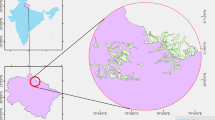Abstract
The extent of the Postglacial is characterized by a main end moraine, which is called Great Lateral Moraine. In general its outer slope is very steep and the recent ice terminal retreated inwards and lost much volume. Between this stage of historical/latest Neoglacial an ice marginal position was found, which can only be classified into the earliest Neoglacial because of its glaciogeomorphic position. It lies ca. 5–6 km outside of the historical moraines and leads to snow line depressions of 300–600 m. This stage can not mixed up with the latest Late Glacial stage. Relating to the Late Glacial only moraine terraces or remnants were found in the steep valleys. In the Kangchenjunga Valley there is a large end moraine complex of Late Glacial at 2700 m, 27 km down-valley of the recent glacier termini and in the Yalung Valley (Simbua Khola, Kangchenjunga SW) we found a lateral moraine wall 600 m above the valley bottom of Torontan. In the Rolwaling Valley several indicators imply a former glaciation of the whole valley, which stretches out into the Bhote Kosi. In consideration of the maximum glaciation of Last Glacial (LGM) which has extended lower than 1000 m in the investigated areas it can be assumed that the levels of moraines valley- inwards are younger. Snow line depressions of 300–600 m for the Neoglacial (earliest stage) and 900–1200 m for the Late Glacial can be calculated.
Similar content being viewed by others
References
Fort M., 1986: Glacial extension and catastophic dynamics along the Annapurna front, Nepal Himalaya. In: Kuhle M. (ed.) Intern. Symp. über Tibet u. Hochasien (8.–11. Oktober 1985), Geogr. Inst. Univ. Göttingen, Göttinger Geogr. Abh. Vol. 81, pp. 105-125.
Heuberger H., 1956: Beobachtungen über die heutige und eiszeitliche Vergletscherung in Ostnepal. Zeitschrift für Gletscherkunde und Glazialgeologie, 3: 349-364.
Heuberger H., 1986: Untersuchungen über die eiszeitliche Vergletscherung des Mt. Everest-Gebietes, Südseite, Nepal. In: Kuhle M. (ed.), Göttinger Geographische Abhandlungen 81 (Internationales Symposium über Tibet und Hochasien vom 8.–11.10.1985), pp. 29-30.
Heuberger H. and Weingartner H., 1985: Die Ausdehnung der letzteiszeitlichen Vergletscherung an der Mount-Everest-Südflanke, Nepal. Mitteilungen der Österreichischen Geographischen Gesellschaft Wien, 127: 71-80.
Jacobsen J.P., 1990: Die Vergletscherungsgeschichte des Manaslu Himalaya's und ihre klimatische Ausdeutung. Geo Aktuell Forschungsarbeiten, 1: 1-82.
Kalvoda J., 1979: The Quaternary history of the Barun Glacier, Nepal Himalayas. Vestnik Ustredniho Ustavu Geologickeho, 54(1): 11-23.
König O., 1999: Preliminary results on the last-high-glacial glaciation of the Rolwaling Himal and the Kangchenjunga-Himal (Nepal, E-Himalaya). In: Kuhle M. (ed.), GeoJournal (Tibet and High-Asia V), 47(1–2): 373-384.
Kuhle M., 1982: Der Dhaulagiri-und Annapurna-Himalaya. Ein Beitrag zur Geomorphologie extremer Hochgebirge. Zeitschrift für Geomorphologie Suppl., 42: 1-229. Kuhle M., 1986: Schneegrenzberechnung und typologische Klassifikation von Gletschern anhand spezifischer Reliefparameter. Petermanns Geographische Mitteilungen, 1: 41–51.
Kuhle, M., 1987: Absolute Datierungen zur jüngeren Gletschergeschichte im Mt. Everest-Gebiet und die mathematische Korrektur von Schneegrenzberechnungen. Tagungsbericht und wissenschaftliche Abhandlung 44 (Deutscher Geographentag 1985 in Berlin): 200-208.
Kuhle M., 1988: Topography as a fundamental element of glacial systems. A new approach to ELA-calculation and typological classification of paleo-and recent glaciation. GeoJournal, 17(4), Tibet and High-Asia, Results of the Sino-German Joint Expeditions (I), 545-568.
Kuhle M., 1990: New data on the pleistocene glacial cover of the southern border of Tibet: The glaciation of the Kangchendzönga Massif (8585 m E-Himalaya). GeoJournal, 20: 319-323.
Kuhle M., 1994: Present and Pleistocene Glaciation on the North-Western Margin of Tibet between the Karakorum Main Ridge and the Tarim Basin Supporting the Evidence of a Pleistocene Inland Glaciation in Tibet. In: Kuhle M. (ed.), GeoJournal, 33(2/3): Tibet and High Asia, Results of the Sino-German and Russian-German Joint Expeditions (III), 133-273.
Kuhle M., 1997: New Findings concerning the Ice Age (Last Glacial Maximum) Glacier Cover of the East-Pamir, of the Nanga Parbat up to the Central Himalaya and of Tibet, as well as the Ice Age of the Tibetian Inland Ice. In: Kuhle M. (ed.), GeoJournal, 42(2–3): Tibet and High Asia. Results of Investigations into High Mountain Geomorphology, Paleo-Glaciology and Climatology of the Pleistocene (Ice Age Research IV), 87-257.
Kuhle M., 1998: Neue Ergebnisse zur Eiszeitforschung Hochasiens in Zusammenschau mit den Untersuchungen der letzten 20 Jahre. Petermanns Geographische Mitteilungen, 142(3/4): 219-226.
Kuhle M., Meiners S. and Iturrizaga L., 1998: Glacier induced hazards as a consequence of glacigenic mountain landscapes, in particular glacierand moraine-dammed lake outbursts and holocene debris production. In: Kalvoda J. and Rosenfeld C.L. (eds), Geomorphological Hazards in High Mountain Areas, pp. 63-96.
Meiners S., 1997: Historical to Postglacial glaciation and their differentiation from the Late Glacial period on examples of the Tian Shan and the N.W. Karakorum. In: Kuhle M. (ed.), GeoJournal, 42(2–3): Tibet and High Asia, Results of Investigations into High Mountain Geomorphology, Paleo-Glaciology and Climatology of the Pleistocene (Ice Age Research IV), 259-302.
Mool P.K., 1993: Glacier lake outburst flood In Nepal. Water and Energy Commission Secretariat (WECS). Scientific Report: 1-10.
Shiraiwa Takayuki and Watanabe Teiji, 1991: Late quaternary glacial fluctuations in the Langtang Valley, Nepal Himalaya, reconstructed by relative dating methods. Arctic and Alpine Research, 23(4): 404-416.
Author information
Authors and Affiliations
Rights and permissions
About this article
Cite this article
Meiners, S. The history of glaciation of the Rolwaling and Kangchenjunga Himalayas. GeoJournal 47, 341–372 (1999). https://doi.org/10.1023/A:1007065727298
Issue Date:
DOI: https://doi.org/10.1023/A:1007065727298




